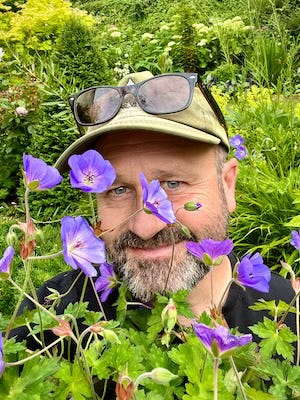From wild places to dirty hands. I’m Elliott at The Gardening Kind
Hello! I’m Elliott Neep, former wildlife photographer, author, and safari guide turned garden-obsessed writer and creator. For 20 years, I travelled the world with cameras in hand, making a name for myself photographing big cats and other predators.
These days, I’m the gardening kind of photographer. Secateurs in my pocket, compost-flecked knees, barrowing leafmould, and tending hostas.
Since falling head-over-booted-heels for gardening in 2018, I’ve designed and created five distinct garden spaces around our 17th-century cottage in Oxfordshire. All organic. All peat-free. All no-dig.
The gardens are woven across a third of an acre, each with its own personality: a sun-drenched courtyard, a dry and shady cottage garden, a raised bed kitchen garden, a terrace garden, and a no-dig flower garden.
I’m a passionate believer in instinctive, ethical, relaxed, and romantic gardening. Think generosity, compost, and a few joyful mistakes along the way.
In 2019, I began sharing my gardening journey on Instagram @thegardeningkind, where over 80,000 lovely plant-minded souls have followed along for the photos, the stories, and the occasional rant about snails.
What you’ll find here on Substack
This is where I share everything I’ve learned in the garden. No character limits. No rushed captions. Just space to dig a little deeper.
You can expect:
• Seasonal tips, organic methods, and no-dig know-how
• Honest garden diaries (the successes and the flops)
• Practical advice and poetic ramblings
• A bit of whimsy, a lot of compost, and plenty of good photos
There’ll be a new long-read post every weekend, with bigger topics broken down into more digestible chunks. I do like a series.
Midweek brings Clippings — short reads of around five minutes, usually easy-to-follow “How to” guides and tips.
Optional paid subscriptions include:
• Exclusive posts, including monthly behind-the-scenes garden tours and extended reads
• Monthly to-do lists, with bonus tips based on what I’m doing in my own garden
• Downloadable treats, like high-res phone and desktop wallpapers from my photography (from my garden and gardens I visit)
• Q&A sessions, where you can send me your burning garden questions
• Full access to the Archive, so you can revisit any post whenever you like
• The Chat function, where you can message me with questions, musings, or the occasional photo of your hostas
• Subscriber-only discount codes from a few of my collaboration partners (I’m working on it)
If you’ve enjoyed following along so far, or if you’re curious to dig a little deeper with me, I’d love to have you as a subscriber.
Whether you stick to the free posts or decide to join the paid tier for a bit more of the good stuff, I’m just chuffed you’re here.
So, pop the kettle on, have a wander through the archives, and if something makes you smile, inspires you, or gets your hands itching for a trowel, then you’re in the right place.
It won’t always be tidy, but it’ll always be honest, hopefully helpful, and occasionally hilarious. Think muddy boots, not manicured borders.
Welcome to The Gardening Kind 🌿



